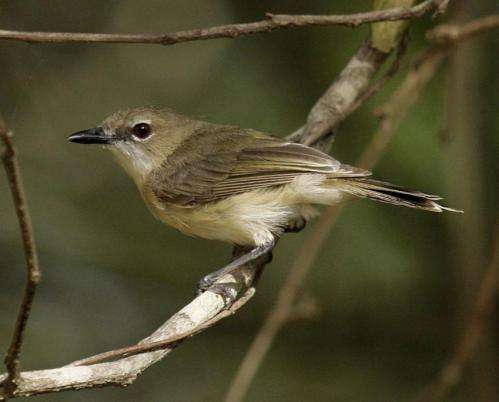Cuckoos hide from each other using 'cryptic' eggs

Cuckoos aren't the kind of parents you'd want. They never raise their young ones, leaving that job to other birds. They achieve this by laying their eggs in other expectant birds' nests, who treat them as their own and take on parenting duties.
Cuckoos are not alone. A whole class of species, called brood parasites, trick other animals to taking on parenting duties. This can be achieved in many ways. Some brood parasites remove a host egg before replacing it with their own. The parasitic chicks can kill the host chicks upon hatching, and the host is left to raise an unrelated chick.
Such behaviour is costly for the hosts, whose nests these alien young ones will leave never to come back and, some times, even negatively affect the hosts' future generations. This is why natural selection favours hosts that are better able to defend themselves against brood parasitism.
This can result in an evolutionary "arms race" between brood parasites and hosts. For example, after the brood parasite has laid its egg in the host nest, some hosts can learn to reduce the the cost of brood parasitism by rejecting the parasite egg. To beat such rejection, natural selection can favour brood parasite eggs that resemble those of their hosts, as these eggs would be more difficult for the host to recognise and reject.
However, it doesn't stop there. Some host populations can then evolve to create individual egg markings that differentiate the host's eggs from the brood parasite's. This is still not enough because, some brood parasites have evolved to track this variation in host eggs and they have learned to mimic this behaviour, marking their own eggs.
These interactions have fascinated birdwatchers for hundreds of years, and they have provided among the most dramatic examples of evolution in nature.
One such interaction involves the use of cryptic eggs. Ros Gloag at the University of Sydney and colleagues attempt to disentangle this case in a paper published in the Proceedings of the Royal Society B.
Some cuckoos lay cryptic eggs, which are dark in colour and don't resemble the host's eggs. Instead they are hidden in dark domed nests, where it is hoped that the host won't find them.
But this may have another advantage, Gloag thought. Because when a few cuckoos try to trick the same host nest, they do so by selectively removing competing cuckoo eggs before laying their own. In such cases, well-hidden dark eggs may help evade other cuckoos' gaze.
Gloag inserted experimental eggs into the nests of large-billed gerygones, Gerygone magnirostris, which are the primary host of the little bronze-cuckoo, Chalcites minutillus, in Cairns, northeastern Australia.
Large-billed gerygones rarely reject little bronze-cuckoo eggs, but it is not known if this is because the dark cuckoo eggs are difficult to see in the small domed gerygone nests, or if this species just does not reject eggs. Little bronze-cuckoos take advantage of the situation and often attempt to parasitise the same gerygone nests. Gloag wanted to know if cryptic eggs were removed by competing cuckoons on purpose or just by chance.
The researchers first located gerygone nests, and monitored them until the first egg was laid. They then inserted two model eggs: one which was painted to resemble a dark coloured cuckoo egg, and the other was painted white.
The gerygones have pinkish-white eggs with pinkish-red speckles. Adding two types of eggs allowed Gloag to test two hypotheses. First, whether gerrygones reject highly visible white eggs that do not look like their own. And second, whether the rejection of dark effs was less than would be expected by chance.
Gloag then waited to see if an egg was rejected from the nest over the following days. If an egg was rejected and no cuckoo egg was found in the nest, this suggested that an egg had been rejected by the gerygone. If an egg was rejected and a cuckoo egg was found in the nest, this suggested that the nest had been visited by a cuckoo which had removed the egg prior to replacing it with its own.
When the results came in, only four out of 23 gerygones rejected any egg, which included both experimental egg types. This means that selection by hosts was unlikely to be responsible for driving the evolution of egg colour in this cuckoo species. By contrast, cuckoos removed eggs prior to laying their own in the majority of nests (20 out of 24).
When looking only at nests where one of the two experimental eggs were removed by a cuckoo, they found that the dark cuckoo egg was less likely to be removed than would be expected by chance. So it seems that competing cuckoos may instead be driving the evolutionary behaviour of laying dark eggs in this cuckoo species.
This is an interesting result that suggests that little bronze-cuckoos are simultaneously locked in two very specific arms races: one between species (in this instance, with the large-billed gerygone), and another within species (other little bronze-cuckoos).
Brood parasites, such as cuckoos, are really useful systems for understanding how interactions between species can affect their evolution in the natural world. This study highlights that they may also be useful for understanding how interactions within a species can drive evolutionary change.
Journal information: Proceedings of the Royal Society B
Source: The Conversation
This story is published courtesy of The Conversation (under Creative Commons-Attribution/No derivatives).
![]()



















